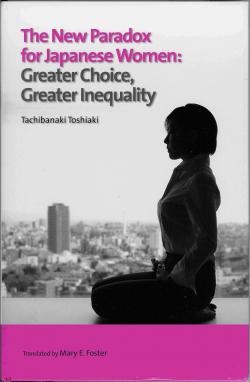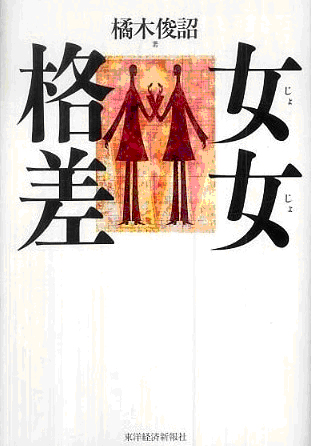The New Paradox for Japanese Women: Greater Choice, Greater Inequality, Toshiaki Tachibanaki (橘木 俊詔)

Translated by Mary E. Foster
I-House Press, Tokyo, 2010
290 pages including index, references and tables
ISBN 978-4-903452-18-0
Review by Sir Hugh Cortazzi
“Japan suffers today from a high inequality in income distribution and a lack of equal opportunity. Simply put, Japan is a class society.” These are the thought-provoking first words of this sociological study by Professor Tachibanaki of Doshisha University in Kyoto. He has studied widely both in North America and Europe and is a recognized authority on economic issues.
Professor Tachibanaki points out that “Japan has long been considered a society where all people are middle class” but “Japan has become a society of increasing social inequality. This is evidenced by the widening gap between rich and poor and the development of rigid social classes.”
The main theme of this book is the increasing social inequality among women in Japan. But especially in his first chapter entitled “The Gender Gap,” he also compares the position of Japanese women with that of Japanese men. The Equal Employment Opportunity Law was introduced in 1985 “to ban discrimination against women and has been strengthened since.” However, as Professor Tachibanaki notes, in Japan “laws may be strict, but the actual observance and enforcement is lax (page 26).” There are few Japanese women in managerial posts and fewer women than men go on to higher education. Moreover Japanese women who do go on to university tend to take shorter courses and generally study humanities and arts subjects. In this context he affirms that “there is no basis for the belief that boys are innately better at mathematics and science than girls (page 74).” He notes on page 83 that “Discrimination against women is an indisputable fact of life in many areas of Japanese society.” He declares (page 85) that “Discrimination against women exists in hiring and promotion in every field” but it is particularly severe when it comes to appointing top executives at major corporations.
The proportion of Japanese women of all ages in full time employment never reaches more than 75% whereas the rate for men “hovers around 95%.” The vast majority of professional/technical workers and manager/officials in Japan are men although the number of women in such posts has been increasing. It is noteworthy that women make up 70-80% of temporary workers in Japan who receive inferior treatment to that accorded to permanent staff.
In Japanese homes most house-work and child care work is performed by women. Professor Tachibanaki does not comment directly on the existence of male chauvinist attitudes in Japan, but the facts which he adduces seem to confirm that this is a not insignificant factor. In Chapter Two which discusses “Women and Social Class” he introduces a table (page 48) which states that among all married couples 85% are male dominated. The percentage is lower in two income families but 74% of such households are still male dominated.
Chapter four on marriage and divorce contains a section on “What are the Japanese looking for in marriage? (page 98 et seq).” Commenting on the economic aspects he stresses the importance of income, educational background and occupation. He notes that the great disparities “between the rich and poor in Japan today have contributed to many young people lacking the funds to get married (page 114).” He records that while 67.7% of married women in their forties condone pre-marital sex the percentage of women in their twenties who approve rises to 87.6% (page 124).

Professor Tachibanaki’s book first appeared in Japanese as女女格差 (Jojo kakusa)
Japan’s low net reproduction rate in an aging society is a matter of concern. To tackle this phenomenon Professor Tachibanaki gives first place to discouraging abortions (page 163) followed by encouraging out-of-wedlock births. In Britain the emphasis is rather on making better provision for childcare and reducing child poverty.
Professor Tachibanaki notes that in Japan as compared with other industrialised countries “a lower proportion of highly educated Japanese women are working (page 189).” One reason for this is that such women trying to return to work after child birth “are unlikely to find a desirable job.”
However the top posts in government ministries and major corporations are no longer monopolised by graduates from the most prestigious universities in Japan and it is becoming recognized that academic credentials do not necessarily confirm an individual’s practical and managerial skills. Major changes are also taking place in Japanese education with more co-education in high schools and universities and some women’s universities are now admitting men
Professor Tachibanaki in his conclusion notes that in Japan “the choices a woman makes will have a major impact on her status and life style” and declares that “Japan faces the urgent task of giving its women equal opportunity and correcting inequalities of result that are not justified.” With an aging and declining population Japan needs more than ever before to make better use of her women.
The importance of the topics discussed in this book is underlined by the fact that Japan Spotlight for May/June 2010 carried a number of articles on related themes under the general headline “Gender Equality Spurs Economic Growth.”
This is a valuable analysis of the problems facing women in Japan today and should be widely read by anyone interested in the future of Japan and its society. I-House press are to be commended for making this important study available to English readers.
This book was originally published in Japanese as 女女格差 (Jojo kakusa), Toyo Keizai, 2008, 344 pages, ISBN-13: 978-4492222836, ¥3,000

